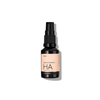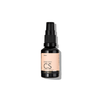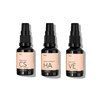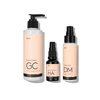Everyday Must-Haves: Your Essential Routine for Normal to Oily Skin
Trying to get the right skincare can be such an overwhelming and tedious thing, especially when you just so happen to have your skin classified as normal to oily. This kind of skin can be pretty much like a balancing act: oily in certain spots, normal in other spots, and breaking out with some annoying shine when things get a little out of hand. Not to worry, though with the right skin care products and routine, you can keep your skin looking its best. Here is your complete guide that will provide you with an efficient daily routine for normal to oily skin. Some of the essential products are included, such as the best eye cream for dark circles, thereby making sure your eyes look bright and fresh.

Knowing Normal to Oily Skin
True start: Before you dive into the actual routine, let's know what normal to oily skin is. It simply means that this type of skin produces more oil than usual, mainly on the T-zone area of the face including the forehead, nose, and chin. At times, having oily skin can be frustrating due to acne and shine tending to occur, but that is not all bad news. Extra oil can help keep your skin well hydrated, thus your skin will appear to stay youthful for much longer.
However, this oiliness needs to be controlled. It is therefore important that the products used regulate the production of sebum without removing the moisture from the skin. Let's dive right into the routine now!
Step 1: Gentle Cleansing
Cleansing is the foundation of any skincare routine, especially when you have normal to oily skin. You want to choose a gentle foaming cleanser that can clear away excess oil and other impurities without drying out your skin. Cleansers containing salicylic acid or benzoyl peroxide prevent acne and clogged pores.
Pro Tip: "Wash your face once a day, morning and night, to get the crude oil and grime out of your skin." Cleansing too much might strip your skin of its natural oil. And if that is stripped off, your skin will secrete even more.
Step 2: Toning
A toner is a step often under-appreciated, with immense potential, especially for oily skin. In most cases, toning helps get rid of impurities from cleansing from your face, while tightening the pores, reducing blackheads and breakouts from appearing. Try to use an alcohol-free toner that has any of the following ingredients: witch hazel, niacinamide, or tea tree oil.
Application Tip: Soak a cotton pad in toner and swipe it over your skin, or pat it on your skin with clean fingers.
Step 3: Exfoliating
Exfoliating is also necessary for normal to oily skin because it removes dead layers of skin cells and unkinks pores. Exfoliate no more than 2-3 times a week to not irritate the skin. Consider using a chemical exfoliant that contains alpha hydroxy acids (AHAs) or beta hydroxy acids (BHAs). Chemical exfoliants like AHAs and BHAs are gentle exfoliants yet very effective to break through to the inside of the skin and get rid of excess oil while encouraging the removal of old cells thus letting your skin look brighter and smoother.
Always apply sunscreen after you have exfoliated the skin in the morning as AHAs and BHAs increase sensitivity to sunlight.
Step 4: Hydration with Lightweight Moisturiser
Most people with oily skin avoid moisturisers because they think it will make their skin even more oily, but a good moisturiser is a must-have for everybody regardless of their skin type. Look for lightweight, oil-free moisturisers that hydrate but do not clog pores. Hyaluronic acid is a good ingredient that will hydrate your skin without the feeling that your skin is heavy.
In addition, a moisturiser can even help regulate oil production since the more dehydrated your skin is, the more it tends to produce oil to offset the dryness. Don't skip this step either!
Step 5: Sun Protection
Sunscreen is never an option, regardless of your skin type. Selecting sunscreens for normal to oily skin should ideally be broad-spectrum having at least an SPF of 30; oil-free, non-comedogenic formulas not clogging pores, and gel-based or mattifying which can help better control shine throughout the day.
Pro Tip: Apply sunscreen as the last step in your morning skincare routine. If you are outside for more than two hours, be sure to apply again.
Step 6: Targeted Treatments
This will be your treatment phase if you have an acne concern or hyperpigmentation. For acne, targeted treatments with benzoyl peroxide or salicylic acid upon spot application will be helpful. For hyperpigmentation, those products containing vitamin C, niacinamide, or retinol will brighten up your skin tone.
During the introduction of new treatments, do it slowly enough not to irritate your skin. You can use them 2-3 times a week initially and then increase to daily or more, depending on your skin's tolerance, during the period.
Step 7: Best Eye Cream for Dark Circles
The under-eye area skin is so thin that it requires special care, even if your skin is normal or oily. The use of the best eye cream for dark circles can reduce the most common complaints: puffiness, dark circles, and fine lines. Dark circles will make you look tired and aged. Therefore, effective eye creams can brighten up the under-eye skin area, restoring your fresh look.
Look for products with ingredients that can decrease puffiness and improve circulation, such as caffeine, or brighten and even out skin tone, like vitamin C. Hyaluronic acid hydrates and peptides stimulate collagen while giving the overall appearance of fine line reduction.
Application Tip: Tap the eye cream using your ring finger. Your ring finger is the lightest touch of all so tap it lightly on the orbital bone. It is nice to use eye cream in the morning as well as at night for better results.

Evening Routine: Don't skip it!
Your nighttime routine is just as important as your morning one. At night, the skin starts to repair itself; it's the perfect time to use more aggressive treatments, such as retinol or overnight masks. Retinol is a powerful ingredient that can work to help fight oiliness, stimulate cell renewal, and the look of pores and fine wrinkles.
If on retinol, always remember to place it underneath your moisturiser and top off with sunscreen the following morning because retinol makes your skin more sensitive to UV rays.
Masking Once a Week
Use clay masks once or twice a week to give your skin a deeper cleanse. Clay masks are perfect for removing impurities from the skin, reducing excess oil, and tightening pores. Kaolin or bentonite clay are preferred in masks because they are effective on oily skin.
Pro Tip: If you have combination skin, apply the mask only on your T-zone so that you do not dry out the more normal parts.
Final Thoughts
Creating a routine for normal to oily skin does not have to be overly complex. It just boils down to consistency and products well-suited to the specific needs of your skin. And using a routine, you can balance your oil production so that the skin stays radiant and fresh. Everyone is different, of course, so it will take some trial and error for you to find what you like, but stick with it, and your skin will thank you.
From the best eye cream for dark circles to the most crucial details, incorporating all of them can and often does make a world of difference in how youthful and bright the skin looks. All you need to do is stick to this routine, based on your skin's response, tweak a little bit, and you're sure to be on your way to balanced healthy-looking skin. All that effort that you put in today will help in that glowy, healthy look tomorrow.
If you're looking to purchase high-quality skincare products to complement your routine, be sure to visit Fether for a range of products designed to cater to your skin's needs.








